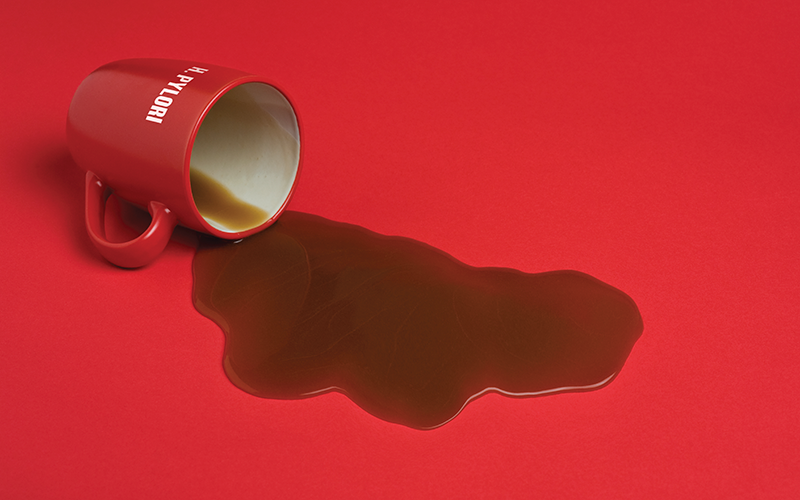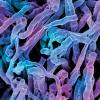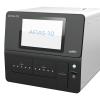In late July 1984, Dr Barry J Marshall drank an unusual concoction that would forever change his life, the lives of countless others and our understanding of medicine. The 32-year-old Microbiology Registrar from Fremantle Hospital, Western Australia, consumed beef broth laced with 109 colony-forming units of Helicobacter pylori (H. pylori).

To discover why Dr Marshall took the elixir and joined an elite club of medical self-experimenters (see box, overleaf), we have to go back three years, to 1979.
At this time, Dr J Robin Warren, a Pathologist at the Royal Perth Hospital, Western Australia, was examining histological sections from gastritis patients. He saw spiral-shaped bacteria in a stomach biopsy sample from a patient with non-ulcer dyspepsia, but further investigation needed expertise in gastroenterology. “I was not focusing on either gastroenterology or microbiology at the time I started my six-month gastroenterology assignment,” Professor Marshall tells The Biomedical Scientist.
“However, I knew that I had an aptitude and an interest in infectious disease, and had been offered a job as an infectious disease trainee that year.”
Where’s the proof?
Marshall and Warren’s challenge was to grow the organism. Their initial failure to do so was partly attributed to faulty incubators and to the routine discarding of plates after 48 hours, if there was no visible growth. But then came a four-day Easter weekend in April 1982. After five days incubation, on 14 April 1982, colonies were seen for the first time.
What was Professor Marshall’s reaction? “My recollection is the same as I always feel whenever I see another medical breakthrough: scepticism. ‘Where’s the proof? What else could it be? What haven’t we thought of?’
“The microbiologist John Pearman had already seen two positive cultures by the time he called me, and explained that the trick was waiting the extra three days to see what developed on the plate (we were already using the right technique). So in some ways I was relieved but had seen too many disappointments with the project so was not going to break open the champagne just on that basis. Also, at that point we did not know we were discovering the cause of peptic ulcers.”
By 1982 Marshall and Warren had begun a prospective investigation of 100 consecutive patients undergoing endoscopy. This was prompted after Dr Chris Sanderson, a Senior Gastroenterologist at the Royal Perth Hospital had advised Marshall: “Barry, you should stop buggerising around and do a proper study!”
The results showed that 65% of patients undergoing endoscopy had gastritis; there was a strong association between spiral bacteria and gastritis and all patients with duodenal ulcers. And 80% of those with gastric ulcers had the organism.
“I remember that 12 out of 13 patients with duodenal ulcer had the bacteria,” recalls Professor Marshall. “This prompted me to review the charts of patient number 13 and I found that, although Dr Warren had not seen the bacteria in our current study, this patient did have the bacteria seen on biopsy a year before, during an investigation for ulcers.
“This was the ‘exception which proved the rule’. I always tell people that anything in medicine which is 100% is likely to be an artefact or ‘fake news’, so I didn’t want to fall into this trap myself. Ultimately, in many studies around the world, the percentage of duodenal ulcer positive for H. pylori was about 92%.”
Marshall and Warren were suggesting not only that a bacterium caused stomach ulcers, but also that patients with ulcers could be treated with antibiotics. This offended the medical establishment. Dr Martin Blaser of the Vanderbilt University School of Medicine described the theory as “the most preposterous thing I’d ever heard; I thought, this guy is a madman”.
Don’t ask, don’t tell
Yet, despite showing a clear association between stomach ulcers and H. pylori, Marshall and Warren had failed to establish an animal model to demonstrate that the organism could colonise histologically normal mucosa and induce gastritis.
This brings us back to Marshall’s famous self-experiment in late July 1984.
“The brew was cultured in the lab and I planned the experiment on the Monday after we saw that the cultures were growing. I drank it on the Tuesday morning at 10am,” says Professor Marshall.
“I pre-medicated myself with some Tagamet, in case the gastric acid was too strong for the H. pylori infection. At that point I did not involve Dr Warren in the exact details of the experiment.
“For my superiors in microbiology and gastroenterology, the situation was ‘don’t ask, don’t tell’,” he adds.
“The taste of H. pylori is ‘no taste’. What I mean is it acquires the taste of the vehicle, for example chicken soup or beef broth. In the lab on that occasion it was dissolved in beef broth, which is a culture medium for lots of different bacteria.”
After five days, Marshall developed bad breath, morning nausea and recurrent vomiting of acid-free gastric juice. A gastric biopsy after 10 days showed acute gastritis and many H. pylori.
“This was one of the most exciting days for me,” enthuses Professor Marshall. “After I had the endoscopy, I did not know for 48 hours what the result was.” The symptoms had spontaneously resolved after a fortnight, but Professor Marshall’s wife, Adrienne, said she’d had enough and demanded that he immediately commence antibiotics or “be evicted from the household to sleep under a bridge”.
Unlock the puzzle
“The pathologist called to show me that the bacteria were causing inflammation,” says Professor Marshall. “Since I had done this part of the experiment myself, I knew the gram stain of gastric mucus was already positive, although the bacteria hadn’t grown at that stage.
“I was very excited after seeing the histology and could not wait to tell my wife once I got home. She’d been in a car accident, resulting in moderate whiplash and cracked ribs, so with four children she was already busy and didn’t want her to have to worry about a sick husband, so she was distressed when I told her the infection had taken hold.
“I knew then that I would have a publication out of it, but did not realise the ultimate importance. Later on, when I was writing the paper and looking through old reports of aetiology unknown infections, I could see that I had unlocked the puzzle of peptic ulcer disease.”
Recognition and acclaim
After publication, there was a shift in medical thinking on the cause of stomach ulcers. This culminated in 1994 at a Consensus Development Conference in Washington DC convened by the US National Institutes of Health (NIH). Most of the 22 researchers who attended supported the claim that peptic ulcers are caused by H. pylori. On 9 February 1994 the NIH panel concluded that ulcer patients with H. pylori infection should be treated with antimicrobial agents.
A string of awards and honours followed (see box on p.20), including recognition of Marshall and Warren’s achievement with the 2005 Nobel Prize.
“Dr Warren and I were at the pub having a beer with fish and chips. It was pretty exciting, but it was the end of a busy and stressful day and I had been up over the weekend preparing slides and then giving a lecture or two each day during the week before. I was overtired and could not really participate much in the celebrations after the announcement, although it was wonderful to see my family and friends having such a great time. Dr Warren and I spent the next few hours on the radio speaking to the various news and media groups around the world. At the end of the evening we were the only sober people remaining and I had to drive everybody else home!”
Still work to do
Thirty-five years after successfully growing the organism, H. pylori has been established as the most common infection known to man and a major cause of stomach cancer.
H. pylori infects up to nine in 10 people in developing countries, but with new combination therapies attaining cure rates of 90%, many lives (and much public money) have been saved. Professor Pentti Sipponen, Head of Pathology at Jorvi Hospital in Finland, says: “Barry and Robin’s discovery has meant enormous savings in healthcare. I estimate this to be billions and billions… Now practically all gastric surgery, except that for cancer, is unnecessary and even unethical.”
But for Professor Marshall, much work remains. “We still don’t know enough about the way H. pylori survives in the stomach during a lifetime, obviously by creating a balance between a pathogenic surface organism and the attempts by the body to eradicate it,” he says.
“It seems to control the immune system because in the stomach a fully-implemented immune reaction would probably bore holes in the mucosa, which would be opened up by the stomach acid leading to dangerous haemorrhage.”
Marshall and Warren’s achievement was the product of a rigorous approach to research, prepared minds that were favoured by serendipity and – in Marshall’s case – a bold and selfless approach towards self-experimentation.
George F Winter is a journalist, author and Fellow of the IBMS.




